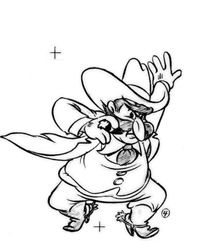The following 12 basic principles of animation were developed by the 'old men' of Walt Disney Studios, amongst them Frank Thomas and Ollie Johnston, during the 1930s. Of course they weren't old men at the time, but young men who were at the forefront of exciting discoveries that were contributing to the development of a new art form. These principles came as a result of reflection about their practice and through Disney's desire to devise a way of animating that seemed more 'real' in terms of how things moved, and how that movement might be used to express character and personality.
It needs to be said that many brilliant moments of animation have been created without reference to, or knowledge of, these principles. However they are appropriate for a particular style of cartoon animation and provide the means to discuss and critique the craft in a language that animators have come to understand - "you need to anticipate that action to give it more punch" - "why don't you put more follow through on the coat tail?"
The following has been paraphrased from the "Illusion Of Life" by Frank Thomas & Ollie Johnston (pp.47-69). For a more extensive explanation of these principles, refer to this seminal text.
The following has been paraphrased from the "Illusion Of Life" by Frank Thomas & Ollie Johnston (pp.47-69). For a more extensive explanation of these principles, refer to this seminal text.
1. SQUASH AND STRETCH
2. ANTICIPATION
3. STAGING
4. STRAIGHT AHEAD AND POSE TO POSE ANIMATION
5. FOLLOW THROUGH AND OVERLAPPING ACTION
6. SLOW-OUT AND SLOW-IN
7. ARCS
8. SECONDARY ACTION
9. TIMING
10. EXAGGERATION
11. SOLID DRAWING
12. APPEAL



.gif)


0 comments:
Post a Comment